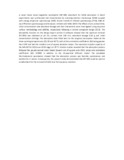Please use this identifier to cite or link to this item:
https://cris.library.msu.ac.zw//handle/11408/1098| Title: | Application of response surface methodology for Cd(II) adsorption on maize tassel-magnetite nanohybrid adsorbent | Authors: | Guyo, Upenyu Makawa, T. Moyo, Mambo Nharingo, Tichaona Nyamunda, B.C Mugadza, Tawanda |
Keywords: | Response surface methodology maize Tassel-magnetite nanohybrid Cd(II) adsorption Central composite design |
Issue Date: | 2015 | Publisher: | Elsevier | Series/Report no.: | Journal of Environmental Chemical Engineering Vol. 3; No. 4: p. 2472-2483 | Abstract: | A novel maize tassel-magnetite nanohybrid (MT-MN) adsorbent for Cd(II) adsorption in batch experiments was synthesised and characterised by scanning electron microscope (SEM) coupled with energy dispersive spectroscopy (EDS), fourier transform infrared spectroscopy (FTIR), XRD (Xray diffraction spectroscopy) and Brunauer, Emmett and Teller (BET)i The effects of pH, contact time,initial concentration and adsorbent dosage and their interactions were investigated using response surface methodology and ANOVA, respectively following a central composite design (CCD). The desirability function on the Design Expert version 9 software showed that the optimum removal (97.26%) was obtained at pH 3.5, contact time 240 min, adsorbent dosage 0.53 g and initial concentration 44.6mgL The adsorption data fitted best to the Langmuir adsorption model at the three working temperatures (20, 30 and 40 °C) with all the correlation coefficients (R2) being greater than 0.99 and had the smallest sum of square deviation values. The maximum sorption capacity of the MN-MT for Cd(II) was 52.05 mgg 1 at 20 “C. Kinetics studies revealed that the adsorption process followed the pseudo-second order model (lowest sum of square error (SSE) values and correlation coefficients (R2) >0.999) in addition to the intraparticle diffusion model. The calculated thermodynamic parameters showed that the adsorption process was feasible, spontaneous and exothermic in nature. Consequently, the present study demonstrated that MT-MN could be used as an adsorbent for the removal of Cd(II) ions from aqueous solutions. | URI: | http://hdl.handle.net/11408/1098 | ISSN: | 2213-3437 |
| Appears in Collections: | Research Papers |
Files in This Item:
| File | Description | Size | Format | |
|---|---|---|---|---|
| guyo abstract.pdf | 23.25 kB | Adobe PDF |  View/Open |
Page view(s)
140
checked on Dec 20, 2025
Download(s)
26
checked on Dec 20, 2025
Google ScholarTM
Check
Items in MSUIR are protected by copyright, with all rights reserved, unless otherwise indicated.



